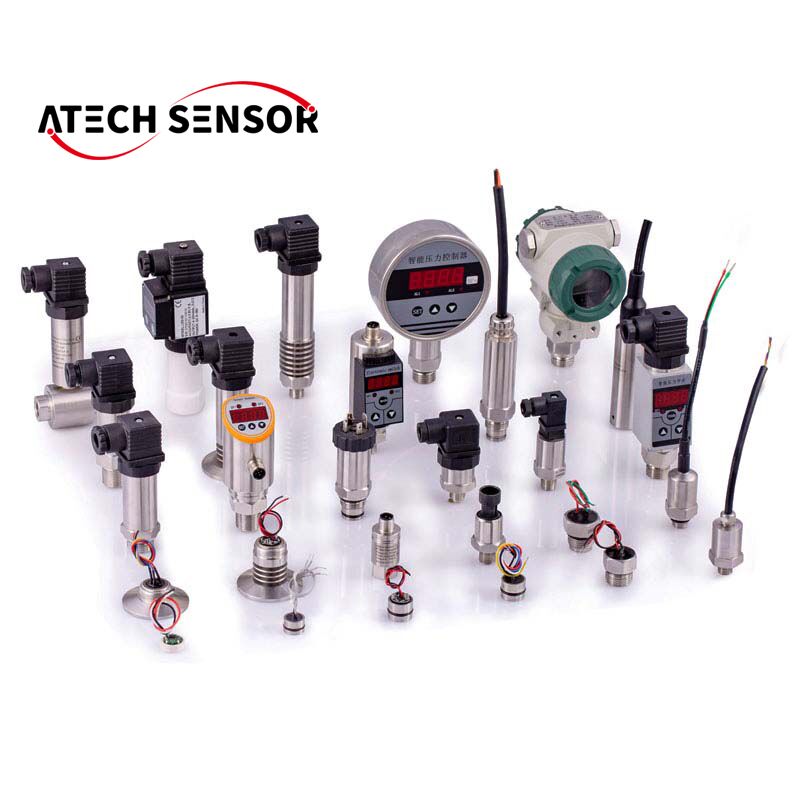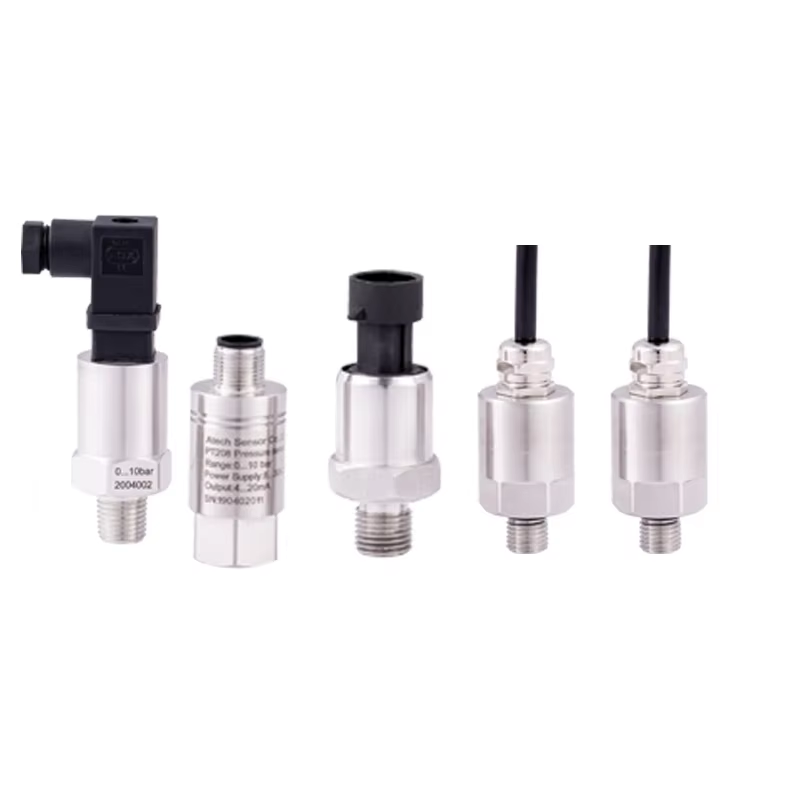Pressure Transducer (Pressure Transducer) is able to feel the pressure signal, and in accordance with certain laws will be converted into a pressure signal available output electrical signal device or device.
Pressure sensors usually consist of a pressure sensitive element and a signal processing unit.According to different types of test pressure, pressure sensors can be divided into gauge pressure sensors, differential pressure sensors and absolute pressure sensors.
Pressure sensors are one of the most commonly used sensors in industrial practice, which are widely used in a variety of industrial automation environments, involving water conservancy and hydropower, railroad transportation, intelligent buildings, production automation, aerospace, military, petrochemical, oil wells, electric power, ships, machine tools, pipelines and many other industries.

Categorization
Diffuse Silicon Pressure Transmitter
Diffusible silicon pressure transmitter is the isolated silicon piezoresistive pressure sensitive element encapsulated in a stainless steel case.It can convert the sensed liquid or gas pressure into a standard electrical signal for external output, DATA-52 series diffusible silicon pressure transmitter is widely used in supply/drainage, heat, petroleum, chemical industry, metallurgy and other industrial processes on-site measurement and control.Semiconductor piezoresistive type
Semiconductor Piezoelectric Impedance Diffusion Pressure Sensor is formed on the surface of a thin sheet by forming a semiconductor deformation pressure, which creates a piezoelectric impedance effect by deforming the sheet by an external force (pressure), so that changes in impedance are converted into an electrical signal.
Electrostatic capacitance type
Electrostatic capacitance type pressure sensors form a capacitance between the fixed pole of glass and the movable pole of silicon, and convert the change in electrostatic capacitance generated by the deformation of the movable pole by an external force (pressure) into an electrical signal. (The principle of operation of the E8Y is the electrostatic capacitance method, while other models use the semiconductor method.)

Wiring Method
Sensor wiring has always been one of the most common problems of the customer procurement process consultation, many customers do not know how the sensor wiring, in fact, a variety of sensors are basically the same wiring, pressure sensors are generally two-wire, three-wire, four-wire, and some have a five-wire system.
Pressure sensors two-wire system is relatively simple, the general customer knows how to wire, a line connected to the power supply positive, the other line is the signal line through the instrument is connected to the power supply negative, this is the simplest, pressure sensors three-wire system is based on the two-wire system to add a line, this line is directly connected to the negative side of the power supply, the more two-wire system a little bit of trouble.Four-wire pressure sensor is definitely two power inputs, the other two are signal outputs.The four-wire system is mostly voltage output rather than 4-20mA output, 4-20mA is called pressure transmitter, most of them are made into two-wire system.Some of the signal output of the pressure sensor is not amplified, the full-scale output is only a few tens of millivolts, while some pressure sensors in the internal amplification circuit, the full-scale output of 0 ~ 2 V. As for how to connect to the display instrument, depending on the range of the instrument is how large, if there is a signal and the output of the appropriate gear, can be measured directly, or else to add a signal adjustment circuit.Five-wire pressure sensor is not much different from four-wire system, and there are fewer five-wire sensors on the market.
Working Principle
Piezoresistive Pressure Sensors
Resistive strain gauges are one of the main components of piezoresistive strain sensors.The working principle of metal resistance strain gauges is adsorbed on the substrate material strain resistance with mechanical deformation and the phenomenon of resistance change, commonly known as the resistance strain effect.
Ceramic Pressure Sensors
Ceramic pressure sensors are based on the piezoresistive effect, where the pressure acts directly on the front surface of the ceramic diaphragm, causing the diaphragm to undergo a small deformation, and thick film resistors are printed on the back of the ceramic diaphragm and connected to form a Wheatstone bridge, which, due to the piezoresistive effect of the piezoresistor, causes the bridge to produce a highly linear, highly proportional to the pressure, and excitation voltage voltage voltage is also proportional to the voltage signal, and the standardized signals are calibrated to 2 0/3/3 mV/V, etc., according to the pressureThe standard signal is calibrated to 2.0/3.0/3.3mV/V etc. depending on the pressure range, and is compatible with strain gauge sensors.
Diffuse Silicon Pressure Sensor
Diffuse Silicon Pressure Sensor Diffuse Silicon Pressure Sensor working principle is also based on the piezoresistive effect, the use of the piezoresistive effect principle, the pressure of the measured medium acts directly on the sensor's diaphragm (stainless steel or ceramic), so that the diaphragm produces a micro-displacement proportional to the pressure of the medium, so that the sensor changes the value of resistance, the use of electronic circuits to detect the change, and the conversion of the output of a standard measurement signal that corresponds to the pressure.pressure of the standard measurement signal.
Sapphire Pressure Sensors
Utilizing the strain-resistive principle of operation, silicon-sapphire is used as the semiconductor sensitive element, which has unparalleled metrological characteristics.Therefore, the use of silicon-sapphire manufactured semiconductor sensitive elements, insensitive to temperature changes, even at high temperatures, but also has excellent operating characteristics; sapphire radiation resistance characteristics; in addition, silicon-sapphire semiconductor sensitive elements, no p-n drift.
Piezoelectric Pressure Sensors
Pressure Sensors The piezoelectric effect is the main working principle of piezoelectric sensors. Piezoelectric sensors cannot be used for static measurements because the charge after an external force is only preserved if the loop has an infinitely large input impedance.This is not the case in practice, so this determines that piezoelectric sensors are only capable of measuring dynamic stresses.

No way to avoid errors
In the selection of pressure sensors we have to consider his comprehensive accuracy, and the accuracy of the pressure sensor by which aspects of the impact?In fact, there are many factors that cause sensor error, the following we pay attention to say four unavoidable error, which is the initial error of the sensor.
First of all the offset error: because the pressure sensor in the whole pressure range of vertical offset to maintain a constant, so the converter diffusion and laser adjustment correction changes will produce offset error.
Secondly sensitivity error: the magnitude of the resulting error is proportional to the pressure.If the sensitivity of the device is higher than typical, the sensitivity error will be an increasing function of pressure.If the sensitivity is lower than typical, the sensitivity error will be a decreasing function of pressure.The cause of this error is due to variations in the diffusion process.
The third is the linearity error: this is a factor that has less influence on the initial error of the pressure sensor, which is due to the physical nonlinearity of the silicon wafer, but in the case of sensors with amplifiers, it should also include the nonlinearity of the amplifier.The linear error curve can be concave or convex curve load cell.
Finally, the hysteresis error: In most cases, the hysteresis error of a pressure sensor is completely negligible because of the high mechanical stiffness of the silicon wafer.Generally, hysteresis errors need only be considered in the case of very large pressure variations.
Pressure sensors of the four errors can not be avoided, we can only choose high-precision production equipment, the use of the latest technology to reduce these errors, but also in the factory at the time of a certain error calibration, as far as possible to reduce the error to meet customer needs.
Common Terminology
Standard pressure
The size of the pressure expressed in terms of atmospheric pressure as a standard, greater than atmospheric pressure is called positive pressure; less than atmospheric pressure is called negative pressure.
Absolute Pressure
The amount of pressure expressed in terms of absolute vacuum.
Relative Pressure
The amount of pressure in relation to the object of comparison (standard pressure).
Atmospheric pressure
Refers to atmospheric pressure.Standard atmospheric pressure (1 atm) is equivalent to the pressure at a height of 760 mm mercury column.、
Round-trip accuracy
The change in pressure at the point of operation obtained by removing the pressure value of the output reversal from the full scale value of the detected pressure when the pressure is increased or decreased at a certain temperature (23°C).
Accuracy
The value obtained by removing the value deviating from the specified value of output current (4mA, 20mA) from the full scale value when zero pressure and rated pressure are added at a certain temperature (23°C).The unit is expressed in %FS.
Areas of application
Pressure sensors are mainly used in: booster cylinders, superchargers, gas-liquid booster cylinders, gas-liquid superchargers, presses, compressors, air-conditioning and refrigeration equipment and other fields.
Applications in Hydraulic Systems
Pressure sensors are used in hydraulic systems to accomplish closed-loop control of forces.When a control spool moves suddenly, a pressure spike of several times the system operating pressure can develop in a very short period of time.In typical traveling machinery and industrial hydraulics, any pressure sensor will soon be destroyed if it is not designed for such extreme conditions.There is a need to use shock-resistant pressure sensors. There are 2 main methods of realizing shock resistance in pressure sensors, one is to change the strain gauge chip, and the other is to connect an external coil. The first method is generally used in hydraulic systems mainly because of the ease of installation.In addition, there is a reason that the pressure sensor has to withstand uninterrupted pressure pulsations from the hydraulic pump.
Applications in Safety Control Systems
Pressure sensors are frequently used in safety control systems, the main area targeted is the safety management system of the air compressor itself.There are many sensor applications in the field of safety control, and it is not surprising that pressure sensors, as a very common type of sensor, are used in safety control systems.In the field of safety control applications generally from the performance aspects to consider, from the price considerations, as well as from the actual operation of the safety and convenience to consider, the actual proof of the choice of pressure sensors is very good.Pressure sensors use mechanical equipment processing technology to install some components and signal conditioners and other devices in a very small chip above.So the small size is also one of its advantages, in addition, the price is also another big advantage.To a certain extent it can improve the accuracy of system testing.In the safety control system, the pressure brought by the compressor is controlled to a certain extent by installing pressure sensors in the piping equipment at the air outlet, which is considered a certain protective measure and a very effective control system.When the compressor starts normally, if the pressure value does not reach the upper limit, then the controller opens the air inlet and adjusts it to maximize the power of the equipment.
Applications in Injection Molding
Pressure sensors have an important role to play in injection molding.Pressure sensors can be installed in the nozzle of the injection molding machine, in the hot runner system, in the cold runner system, and in the mold cavity of the mold. They measure the pressure of the plastic from the nozzle of the injection molding machine to the cavity of the mold somewhere during the injection, filling, holding and cooling processes.
Anti-corrosion tips
Pressure sensors are used in all walks of life, especially industrial applications are very much pressure sensors, but the industry generally requires pressure sensors can be corrosion-resistant, pressure sensors joints and chambers using imported stainless steel overall processing, as a pressure transmitter elastomer stainless steel materials with high corrosion resistance, good attenuation performance, you can monitor any media compatible with 316L.Here we also introduce the pressure sensor corrosion techniques.
First of all, know whether the measured medium is compatible with 316L: 316, 317L alloy in 100 hours 5% salt spray test, there is no corrosion.Secondly, in the purchase of sensor products, to the supplier to consult the medium on the pressure sensor whether there is an impact; through the selection of corrosion-resistant materials of the bullet body in order to meet the needs of the user to use.Finally, we can use isolation methods: pressure transmitter before the molybdenum 2 titanium and tantalum sheet, diaphragm and ballistic tube with methyl silicone oil between the transmission pressure, the minimum range can be done 0 ~ 100kPa, if the diaphragm material is not yet corrosion-resistant, it can be added to a layer of F46 diaphragm, but the instrumentation sensitivity has been reduced.F46 can also be used directly for the isolation of the diaphragm, the transfer fluid can be selected fluorine oil, it can play a double role in isolation.
Pressure sensors in the use of the process once found that it can not be compatible with the medium must immediately replace the sensor, corresponding to some special media we can use special materials or special structures to measure the pressure sensor will certainly be more widely used in the future, so as a manufacturer we have to actively develop new types of pressure sensors to adapt to the needs.

